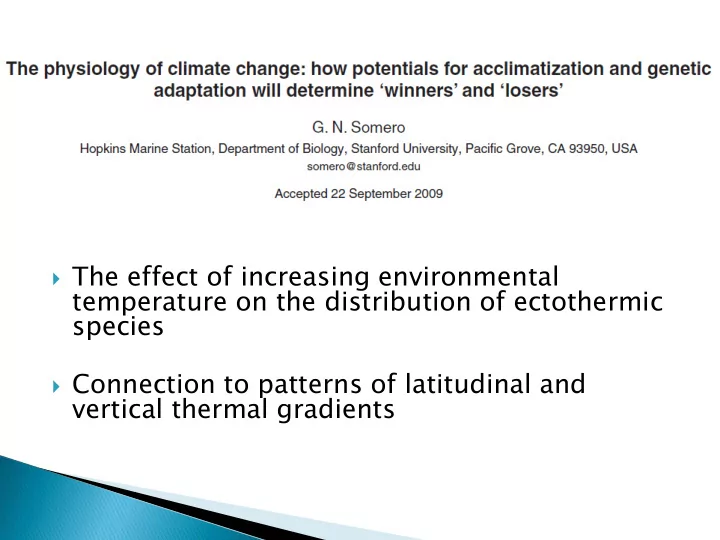

The effect of increasing environmental temperature on the distribution of ectothermic species Connection to patterns of latitudinal and vertical thermal gradients
How do thermal tolerance limits differ among species? What physiological systems set thermal tolerance limits? Can temperature- adaptive protein evolution ‘keep up with’ global warming? Do gene regulatory capacities of stenothermal and eurythermal species differ?
Congeneric Porcelain Crabs (genus Petrolisthes) LT50 – acute lethal temperature LT50 vs. latitude and height • Results ts: : tropi pical cal/s /subtr ubtrop opic ical al species es and those e occurr urring ing highest st in the intertid tidal al zone had higher er LT50’s; adaptiv ive e variation ation – more heat tolerant ant
MHT – maximal habitat temperature MHT vs. LT50 • Re Results ts: in latitudinal udinal groups ps the most heat-tole tolerant rant speci cies es are most t threatened tened by further her incr creases ases in temperature because current MHT’s reach or exceed LT50’s
• Whelks (Nucella canaliculata) • Intraspecific differences in thermal tolerance
• Results: • Inter-population differences in LT50 • Oregon – higher LT50’s • Differences are most likely genetically based
• Conclusion: possibility of Oregon populations replacing lower latitude pop’s that face local extinction from increasing temp’s
• Congeneric Porcelain Crabs (genus Petrolisthes) • Cardiac function = cause of acute thermal death • CTmax – critical thermal maximum • After this temperature, recovery is not observed
LT50 vs. CTmax LT50 = CTmax • Conclusion: connection between whole animal thermal tolerance and collapse of organ function
Acclimation – change in physiological function occurring as a result of alteration of an environmental parameter usually experimental manipulation Acclimatization – change in physiological function occurring as a result of complex natural environmental changes
Differences between warm-adapted and temperate congeners of Petrolisthes Warm - CTmax by 0.3 and 0.9 C Temperate - CTmax by 1.2 and 2.2 C Conclusion – warm-adapted species are less able to acclimate by increasing CTmax and LT50
• Congeneric species of Limpets (genus Lottia) • Higher whole-organism thermal tolerance in southern species • Orthologs of cytosolic malate dehydrogenase (cMDH) for the two species are adapted to different temperatures
• Southern species – cMDH ortholog is more thermally stable it loses activity less rapidly than that of northern species • Only a single amino acid difference distinguishes the two orthologs
• Only a single amino acid substitution is necessary to adaptively modify cMDH’s thermal sensitivity • Sites of adaptive change influence cMDH’s conformational mobility o Numerous sites influencing energy changes linked to conformational mobility o Adaptive change has a number of ‘ targets ’, and only one needs to be ‘ hit ’ for adaptation • Con onclu lusio ion : Adaptive protein evolution might be able to ‘keep up with’ global warming
• Change from glycine serine
• Genomic loss required for life at high temperatures • Due to long evolutionary periods living at stable conditions of low temperature • Types: o Protein coding genes lost o Mutations disrupting open reading frames of protein coding genes o Lesio ions s in gene e regulat latory ory regions ions
Cold-adapted stenotherms ◦ Antarctic marine ectotherms Lesions in gene regulatory regions ◦ Negatively impacts acclimatization (vs. eurytherms) ◦ Eliminates ability to regulate gene expression (modify transcriptional processes) in face of thermal stress ◦ Loss of HSR (heat-shock response) unable to repair damaged proteins caused by thermal stress ◦ Also, loss of protein-coding genes These impacts cause extreme stenothermality •
Warm-adapted, low latitude, high sites = most threatened by further increases in temperature because: ◦ Proximity of LT50 and CTmax to MHT ◦ Limited ability to increase LT50 and CTmax through acclimation • ‘Losers’ are the warm -adapted eurytherms and the extreme cold-adapted stenotherms
Recommend
More recommend